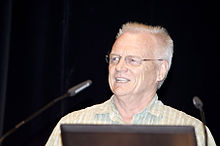Gary Stormo
| Prof. Gary Stormo | |
|---|---|

Gary Stormo speaking at ISMB/ECCB 2013.
|
|
| Born | Gary Dean Stormo 1950 (age 66–67) South Dakota, USA |
| Fields |
Bioinformatics Genetics Molecular biology |
| Institutions |
University of Colorado Boulder Washington University in St. Louis |
| Alma mater |
California Institute of Technology University of Colorado Boulder |
| Thesis | Computer-aided characterization of translational initiation sites in E. coli (1981) |
Gary Stormo (born 1950) is an American geneticist and currently Joseph Erlanger Professor in the Department of Genetics and the Center for Genome Sciences and Systems Biology at Washington University School of Medicine in St Louis. He is considered as one of the pioneers of bioinformatics and genomics. His research combines experimental and computational approaches in order to identify and predict regulatory sequences in DNA and RNA, and their contributions to the regulatory networks that control gene expression.
Stormo initially majored in physics as an undergraduate at the California Institute of Technology, but switched to biology in his junior year. He received his PhD in molecular biology in 1981 from the University of Colorado at Boulder.
Following his PhD, Stormo stayed at the University of Colorado as a faculty member in the department of Molecular, Cellular and Developmental Biology, becoming a professor before moving to Washington University in St. Louis in 1999.
Stormo's research combines experimental and computational approaches to understand regulation of gene expression. His experimental work focuses on protein–DNA interactions and their role in gene regulation. His computational work involves analysis of these interactions and developing pattern recognition algorithms to discover regulatory sites in DNA and RNA.
In 1982, Stormo and his colleagues introduced the Position Weight Matrix (PWM), a now commonly used representation of motifs (patterns) in biological sequences.Consensus sequences had previously been used to represent patterns in biological sequences, but had difficulties in the prediction of new occurrences of these patterns. The first use of PWMs was in the discovery of RNA sites that function as translation initiation sites. The advantages of PWMs over consensus sequences have made PWMs a popular method for representing patterns in biological sequences and an essential component in modern algorithms for motif discovery.
...
Wikipedia
